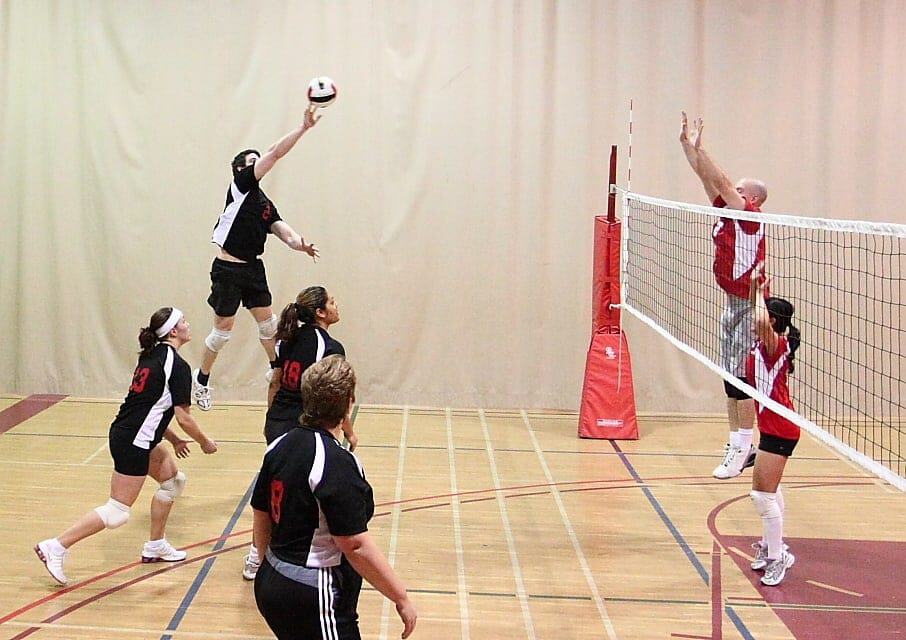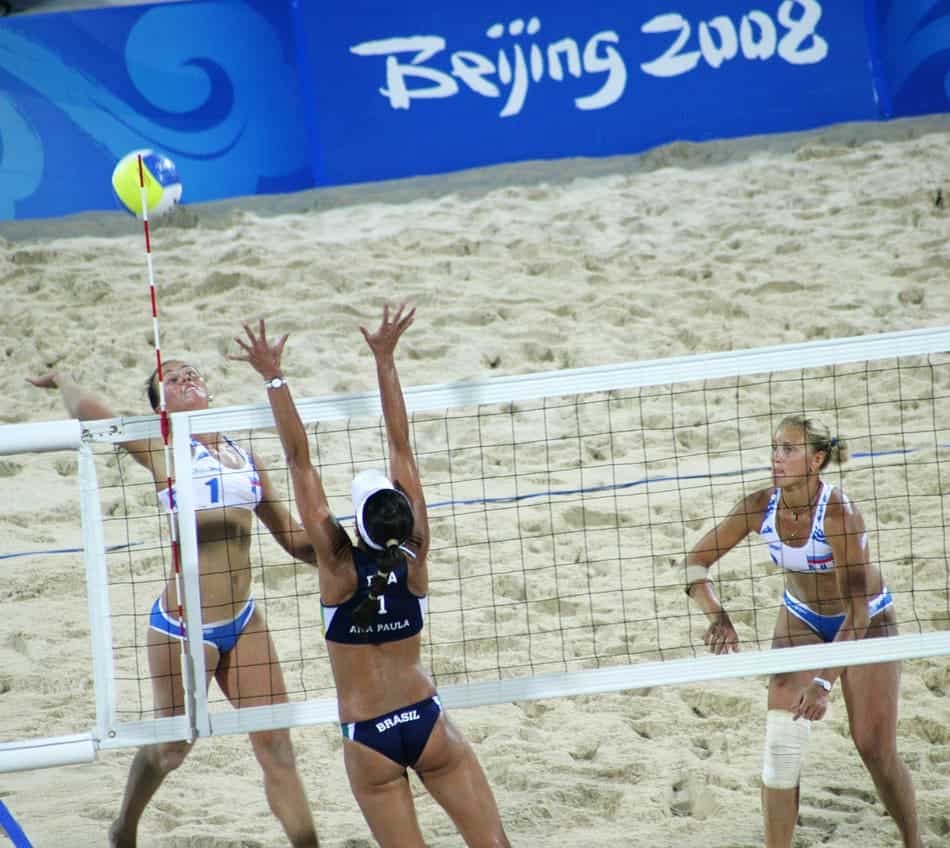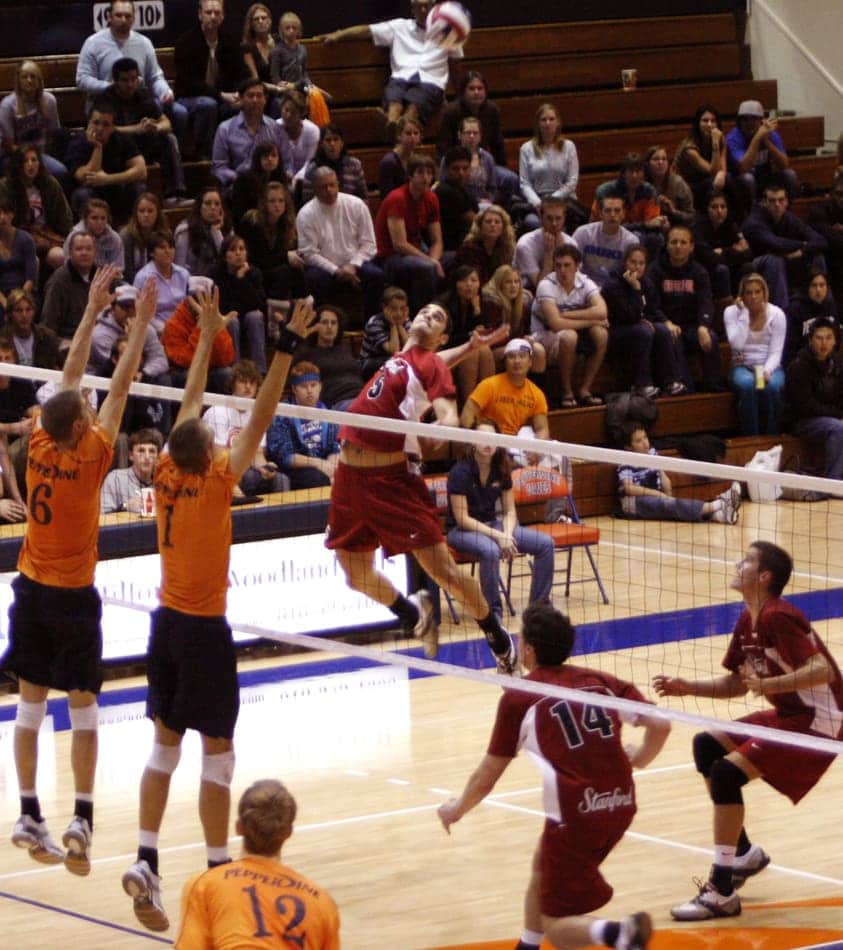Hitting in volleyball is the act of offensively attacking the ball to make it difficult or impossible for your opponent to play the ball. You are trying to end the rally by killing the ball on their side of the court.
What are some great volleyball hitting drills?
1. Hitting Drills For The Back Row
2. Advanced Hitting Drills
3. Hitting Drills For One Person (Solo)
Hitting Drills For The Back Row
Back Row Attacks With Ball Control
For this drill, the team is split half on each side of the court. Each side starts with a player in the back middle position and a setter. The rest of the players line up behind the back middle at the endline.
The coach begins with a free ball to a back middle. The back row player passes to the setter, who sets for a back-row attack.
The back row attacker executes a back-row attack aiming to control the ball and send it to the opposite back-row player. The other side repeats.
During this drill you rotate, after you playback middle, you play the setter. Then you get in line at the endline.
This drill is to teach confidence and comfort with a back-row attack. As players become very good, have them change from targetting the back row player, to avoiding the back row player. Also in this drill, everyone practices the basics of setting.

Back Row Sniper
This drill starts with 3 passers and a setter on each side of the net. The coach starts with a free ball to one of the passers.
They pass to the setter, then get prepared for a back-row hit. The setter sets the player who passed them the ball.
The hitter then targets one of the opposing players. They must hit their attack within one step of one of the opposing players. If they don’t they’re out of the drill. The last passer left at the end wins the game.
This drill is about consistency and targeting from the back row attack.
Advanced Hitting Drills
Hitting From The Box
Hitting from a hitter’s box allows a player to focus on the positioning and mechanics of a strong attack without controlling the variables of jumping, tracking the ball and timing. This allows a coach the opportunity to freeze a player’s motion, point out errors, and make adjustments.
Place the box directly in front of the net wherever this hitter is when they play their position. Have them begin by self-tossing and using good technique in hitting the ball.
A few basic pointers:
1. Your hips should be open to your setter. This allows you to approach the ball at the correct angle.
2. Position your feet in the right order as if you’ve just made your regular left, right, left approach.
3. You non-hitting arm is your lead arm and should be raised as you begin your swinging motion.
4. At the same time that your lead arm is raised, your hitting arm should begin with your elbow coming back, ready to strike.
5. As you swing, you want to attack the ball with a good snap of the wrist to create topspin on the ball to keep it from sailing out of bounds.
6. You should contract your core muscles for extra power, and this should make you end in almost a bowing position (this is more obvious working from the box than it is when you jump).
Variations:
1. Begin with a slow self-tossing method with the coach giving feedback.
2. Have someone else set or toss the ball.
3. Set up a target or a few targets on the opposing court – hula hoops are a great size.
It’s critical that this drill is used for practicing good form. If players are not using good technique during this drill, they will be creating and reinforcing bad habits that will make hitting a live ball even harder.
Attacking The Line
On each side, you need a hitter, a setter and a passer. The coach should have a rack or cart of balls near the net.
The hitters are lined up outside. The coach sends a free ball to a passer, who passes to a setter. The setters

The defender on the opposite side attempts to dig and keep the drill going. Since every hitter is hitting
Variation: Have the players rotate positions by following their ball after contact.
The point of this drill is to build accuracy with hitting line. Many hitters avoid hitting line because they fear hitting out of bounds.
Tip The Bucket or Kill The Cart
For this drill on one side, you’ll need a ball cart positioned in the middle of the court. A server can stand beside the cart.
Usually, this will be your libero or a setter if you have 2 setters. Then you’ll need 2 blockers to the left and right.
On the opposing side, you’ll need a middle back passer, a setter, and a left-side hitter, and a right-side hitter. The rest of the team line’s up behind the middle back at the
The server serves a controlled ball to the middle back passer. The passer passes to the setter. The setter chooses which hitter to set and the setter attacks the ball.
The hitter has 3 options:
1. Execute a regular kill = 1 point
2. Tip the ball into the ball cart = 3 points
3. Hit the ball cart with a kill = 7 points
After their hit or attempt, the hitter rotates out with the blocker across the net. The blocker rotates to the endline. The setter stays and the server stays.
Play to a pre-determined amount of points, making it a competition between hitters as to who can win the game. We usually play to 21 because 3 kills would get you a win.
This drill is meant to coach focusing on a target and controlling the ball getting there. Once the team has become used to the drill, move the cart to challenge them. Some players will excel at tipping while others will be able to kill the bucket surprisingly consistently.

Hit And Run
In this drill, the offense will compete against the defense. On the defensive side, you have 3 passers, a setter, and 2 blockers. On the offensive side, you have all the outside hitters and a setter.
You need an object place on each of the back corners of the court – you can use a chair or a trash can. The setter on the defensive side is simply a target, so if you’re short a player, this isn’t a critical position to have filled.
The hitters are lined up outside or right side in an even number (your middle hitters should be blocking on the defense for this drill).
The coach or feeder lobs a ball to the setter, who sets to alternating hitters. The hitter strikes the ball and then has to run to the back corner of the opposite side of the court than they are on, then back to their position for another hit.
If the hitter gets a no-touch kill, they get a point.
On the defensive side, they are trying to block and dig. If they get a stuff block (the ball doesn’t cross the net), they get a point. If they get a 3-grade pass, they get a point. For a description of a 3-grade pass, scroll down to the bottom of this article.
Any other result is a wash (no points for anyone). So for instance, the passer makes contact, but shanks the pass – it’s a wash. The blocker makes contact but the point is lost, it’s a wash.
The goal of the game is for the defense to win 15 points or the offense to win 10 points, whichever comes first.
Variation – it would be fine to give middle hitters a chance to hit and run another cycle of this game with middle forming one line and using 2 of your outside hitters to block.
The point of this drill is to foster competition in a high-speed drill. The coach may offer rewards or punishments for whichever team wins or loses as they see fit.
Hitting Around The Permanent Block
In this drill, you will need a hitter’s box set up for a blocker, tight to the net. On the offensive side, you will need a passer, a setter, and a hitter.

The coach or feeder lobs a ball over to the passer, who passes to the setter. The setter sets the ball outside, in a typical outside hitting zone. The blocker will be there, ready and waiting, forming the typical block. They should just set up a strong block and hold it, not adjusting to the ball or hitter.
The hitter has the objective of hitting around the block. Choose either angle or line and work the ball past the block. If the set is absolutely in front of the block they can go for a tip but should work to avoid this.
To add difficulty to this drill, add a second blocker. Again, the blockers should set up a typical block and not adjust very much to the ball or hitter.
They already have a strong advantage in not having to jump and time the ball. They are just forming the obstacle for the hitter to learn to workaround.
Another level to this drill would be for the blockers to spread out leaving a gap in the middle, and for the hitter to have the goal of hitting the seam in between the block.
Coaches should focus on training good judgment skills on when to adjust to the ball and modify your hitting plan.
For more details on improving your hitting, check out our post called How To Nail Your Hand Position While Spiking.
Volleyball Hitting Drills For One Person (Solo)
The “Hitting From The Box” drill listed above is an ideal one-person drill, but often you won’t have a net or a hitting box when you are trying to improve on your own, so here are some other drills to help.
Hitting The Wall
You can almost always find a wall to practice against. As you can imagine, millions of volleyball players have spent quality time hitting, passing, and serving against the wall.
One of the keys to remember when you’re hitting into a wall is that this isn’t serving practice, don’t give yourself a perfect toss just out of reach. Your setter sets far above your head, use this practice to simulate that. This will help you get better at tracking the ball in the air and getting under it at the right time.
Also, try your best to practice good form. If you skipped down to this part of the article, scroll back up and take a peek at the section called “Hitting From The Box.”
You don’t have a coach to point errors out, but you should still try to use good form. Stop and examine your own position and swing every so often to make sure you’re doing it right.
Jump Squat Exercise
One of the parts of hitting you can work on by yourself is your jumping power. One of the best exercises for this is jump squats. Now you can do jump squats without any added weight, but ideally, you want to use a small amount of weight to add to the difficulty.
If you have a barbell, use it by itself, loading it onto your shoulders. If you have dumbbells, just use 5-10 pounds for this move.
You’re going to do a squat at high speed and jump into the air. Start with your feet a little wider than shoulder-width apart. You want your feet exactly even in a straight line.
From a relaxed standing position, quickly squat until your thigh is about 45 degrees and then explode upward and jump off the ground. Land softly, return to your stance. Do sets of 20.
Bouncy Medicine Ball Exercise

Another part of hitting that you can increase on your own is your arm swing speed. More arm speed = more power. The faster you can hit, the more options you will have in the air and the more control you’ll have when you need it.
For this exercise, you’ll need a bouncy 5 to 10 pound medicine ball. Depending on how bouncy the ball is, you may need to stand on a platform, usually 1 to 1 ½ feet off the ground.
Begin by holding the ball above your head. As quickly as possible, with both arms, slam the ball to the ground. Bend over to catch the bounce, grab it with both hands, and bring it back behind your head. As soon as you reach back, slam it back down again.
Do 3 sets of 10 fast reps with this exercise. You should be focusing of flexing the muscles you use for this slamming motion.
Your lats – the muscles that run along the side of your torso, your abs – your core, your stomach, and your triceps – the muscles that run along the backside of your arms between your shoulder and your elbow. These 3 muscle groups control just how quickly you can bring your hand down to crush the volleyball when it’s time to hit.
Related Questions
What Is The Middle Hitter In Volleyball?
In volleyball, the middle hitter is one of the positions. It’s also called the middle blocker. This is usually the tallest player on the team and they play the front middle position. They are responsible for attacking the ball on offense and blocking on defense.
What Is Considered A Kill In Volleyball?
In volleyball, a kill is an attack that isn’t returnable by the defender on the other team and leads immediately to a point. This can be by directly hitting the floor or by sending the ball that is so difficult to return, the defender can’t play it successfully.
What Is The Attack Line In Volleyball?
The attack line in volleyball is also called the 10-foot line or the 3-meter line because that is the distance of the line from the net. This line is the boundary that separates the front zone of the court away from the rest of the court. Back row players are not allowed to attack the ball above the height of the net from within the attack line.
To learn more about different volleyball lingo, check out our post called Volleyball Terms, Stats, Acronyms & Abbreviations.
What Is A 3-Grade Pass In Volleyball?
Not all passes are created equal! A 3-grade pass in volleyball is the best possible pass, it’s a pass that allows your setter to choose any of the 3 hitters to set. For this to be true, there must be control, the ball must be sent to the target, and it must have enough height to allow time for the setter to make the play.
In a pass grading system, 0 is given for pass attempts that result in the other team getting the point. A 1 is given for a pass that gets the ball in the air, but really only gives the team a slim chance to play.
A 2 is given for a pass that allows the setter to choose between 2 hitters to set. The 3 is for the ideal, beautiful pass that we all want to make!
Photo credits:
Feature image by Tania Van den Berghen from Pixabay
Backrow hitting image by Alex Dixon on flickr.com: https://creativecommons.org/licenses/by-nd/2.0/
Beijing 2008 image by Bob Denaro on flickr.com: https://creativecommons.org/licenses/by/2.0/, cropped.
Red vs. orange image by Chris Michaels on flickr.com: https://creativecommons.org/licenses/by/2.0/
Hitting around the block image by KLM volleyball on flickr.com: https://creativecommons.org/licenses/by-nd/2.0/, cropped.
Medicine ball image by Nicole De Khors from Burst
Recent Posts
Athletes, listen up! Do you have a closet full of old jerseys, sweatpants, and tees that you just can't seem to part with? Well, dust them off, because you're sitting on a goldmine of fashion...
You may have heard, or you may have noticed, that there's been a change to the rule about double contact in volleyball. In 2022, an experimental rule change began to be implemented, where the double...
